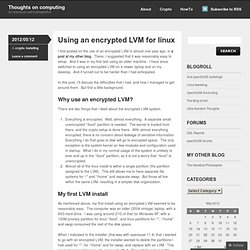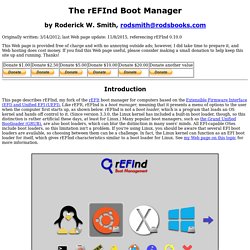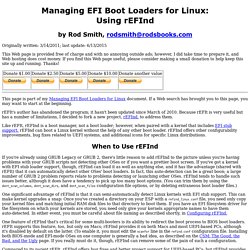

Linux Live USB on MAC. Kali Linux ISO of Doom. In our last blog post, we provided an example of running an unattended network installation of Kali Linux.

Our scenario covered the installation of a custom Kali configuration which contained select tools required for a remote vulnerability assessment using OpenVAS and the Metasploit Framework. With just a few minor changes to this concept, we can further leverage Kali to create other cool and shiny toys as well. In today’s post, we’ll see what it takes to create what we fondly refer to as “The Kali Linux ISO of Doom”. The idea we had was tbao build an “unattended self-deploying” instance of Kali Linux that would install itself on a target machine along with a customized configuration requiring no user input whatsoever. On reboot after the installation completes, Kali would automagically connect back to the attacker using a reverse OpenVPN connection. There could be several uses for such an image: The second scenario is rather cool. . # Now we create the client keys. Welcome – SUSE Studio.
Features. How to Boot A Linux Live USB Stick On Your Mac. Advertisement Get Linux to boot, on your Mac, from a USB stick or external hard drive.

A simple program called Mac Linux USB helps make a formerly complex process simple, and is a godsend for those without optical drives. So you want want to boot Linux, from a flash drive, on your Mac? If you’re reading this, you probably already know it’s harder than it should be. Old standbys like uNetBootin – while available for your Mac – do not create USB keys your Mac can actually boot. Don’t worry. All processes below were tested on a 2011 Macbook Pro – one that refused to boot any and all USB disks created by uNetBootin and similar tools. One more thing: If there is anything on your USB stick back it up now – we will likely delete everything on it during the process.
Step 1: Check And Format Your Drive Note: this step might not be necessary for everyone, but for me made the process foolproof. To get started, ensure your USB stick is properly formatted – we need a FAT32, MBR drive. Conclusion. MactelSupportTeam/AppleIntelInstallation. As with all wiki documentation, this page continues to be updated.

The partitioning options require additional testing. This information will not work for iMac (11,1 or newer) users installing recent versions of Ubuntu (e.g., Maverick, Precise, Quantal...), for this you may try this guide Ubuntu 12.10 on 2011 imac. The presence of the bios-grub partition that the Ubuntu installer creates by default (e.g., sda3) causes a conflict that prevents syncing the GPT and MBR partition tables.
Deleting sda3 does not help since grub2 requires that bios-grub partition, nor will it use either sda or sda4 aborting with the error: "This GPT partition table has no BIOS boot partition; embedding won't be possible! ". So installing Ubuntu with the bios-grub partition fails and installing without it fails. Slightly adventurous Intel-based Mac ("Mactel") owners seem to often be afraid or confused about installing Ubuntu alongside OS X, but it is not very difficult. Using an encrypted LVM for linux. I first posted on the use of an encrypted LVM in almost one year ago, in a post at my other blog.

There, I suggested that it was reasonably easy to setup. And it was in my first test using an older machine. I have since switched to using an encrypted LVM on a newer laptop and on my desktop. And it turned out to be harder than I had anticipated. In this post, I’ll discuss the difficulties that I had, and how I managed to get around them.
The rEFInd Boot Manager. By Roderick W.

Smith, rodsmith@rodsbooks.com Originally written: 3/14/2012; last Web page update: 11/8/2015, referencing rEFInd 0.10.0 This Web page is provided free of charge and with no annoying outside ads; however, I did take time to prepare it, and Web hosting does cost money. If you find this Web page useful, please consider making a small donation to help keep this site up and running.
Thanks! Introduction This page describes rEFInd, my fork of the rEFIt boot manager for computers based on the Extensible Firmware Interface (EFI) and Unified EFI (UEFI). In theory, EFI implementations should provide boot managers. I decided to fork the earlier rEFIt project because, although rEFIt is a useful program, it's got several important limitations, such as poor control over the boot loader detection process and an ability to display at most a handful of boot loader entries on its main screen. As already noted, rEFInd is a boot manager for EFI and UEFI computers. Managing EFI Boot Loaders for Linux: Using rEFInd. By Rod Smith, rodsmith@rodsbooks.com Originally written: 3/14/2011; last update: 6/13/2015 This Web page is provided free of charge and with no annoying outside ads; however, I did take time to prepare it, and Web hosting does cost money.

If you find this Web page useful, please consider making a small donation to help keep this site up and running. Thanks! This page is part of my Managing EFI Boot Loaders for Linux document. rEFIt's author has abandoned the program; it hasn't been updated since March of 2010. Like rEFIt, rEFInd is a boot manager, not a boot loader; however, when paired with a kernel that includes EFI stub support, rEFInd can boot a Linux kernel without the help of any other boot loader. rEFInd offers other configurability improvements, bug fixes related to UEFI systems, and additional icons for specific Linux distributions.
When to Use rEFInd. ELILO: EFI Linux Boot Loader - Browse Files. The LiveCD List.